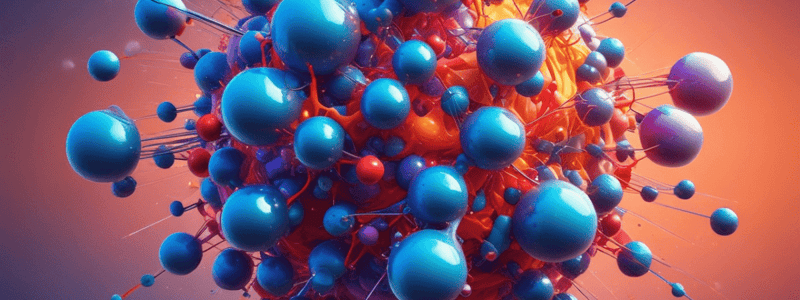Podcast
Questions and Answers
According to the collision theory, what must particles possess for collisions to be effective?
According to the collision theory, what must particles possess for collisions to be effective?
- Minimum amount of energy (correct)
- No energy requirement
- Variable amount of energy
- Maximum amount of energy
What is activation energy in a chemical reaction?
What is activation energy in a chemical reaction?
- The energy of the colliding molecules
- The energy absorbed during a reaction
- The energy released during a reaction
- The minimum energy required for a reaction to occur (correct)
What is one of the factors affecting reaction rates according to the text?
What is one of the factors affecting reaction rates according to the text?
- Temperature of the surroundings
- Color of the solution
- Concentration of reactants (correct)
- Volume of the solution
Why is proper orientation important for effective collisions between molecules?
Why is proper orientation important for effective collisions between molecules?
What role does the collision theory attribute to molecules in a chemical reaction?
What role does the collision theory attribute to molecules in a chemical reaction?
What is concentration with regard to chemical reactions?
What is concentration with regard to chemical reactions?
What is the relationship between the concentration of reactants and the rate of a chemical reaction?
What is the relationship between the concentration of reactants and the rate of a chemical reaction?
What is the effect of increasing temperature on the rate of a chemical reaction, according to collision theory?
What is the effect of increasing temperature on the rate of a chemical reaction, according to collision theory?
What is the relationship between surface area and particle size for solids?
What is the relationship between surface area and particle size for solids?
What is the primary function of a catalyst in a chemical reaction?
What is the primary function of a catalyst in a chemical reaction?
In a homogeneous catalytic reaction, what is the phase of the catalyst relative to the reactants?
In a homogeneous catalytic reaction, what is the phase of the catalyst relative to the reactants?
What is the typical phase of a heterogeneous catalyst?
What is the typical phase of a heterogeneous catalyst?
Flashcards are hidden until you start studying




